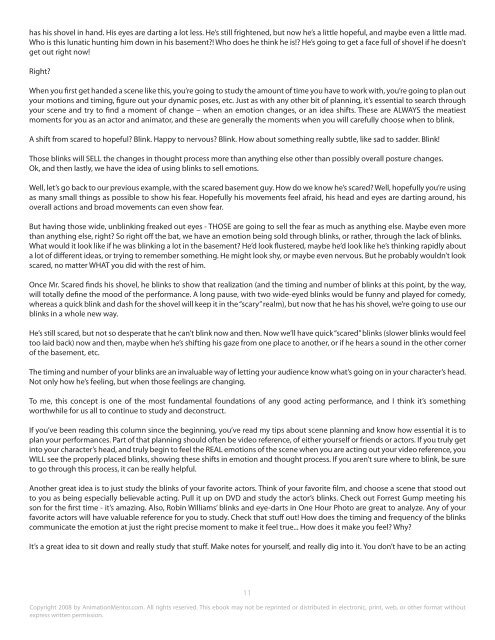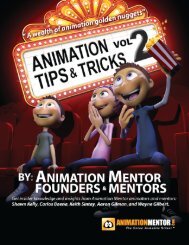Animation Tips & Tricks, Volume I - Animation Mentor
Animation Tips & Tricks, Volume I - Animation Mentor
Animation Tips & Tricks, Volume I - Animation Mentor
You also want an ePaper? Increase the reach of your titles
YUMPU automatically turns print PDFs into web optimized ePapers that Google loves.
has his shovel in hand. His eyes are darting a lot less. He’s still frightened, but now he’s a little hopeful, and maybe even a little mad.Who is this lunatic hunting him down in his basement?! Who does he think he is!? He’s going to get a face full of shovel if he doesn’tget out right now!Right?When you first get handed a scene like this, you’re going to study the amount of time you have to work with, you’re going to plan outyour motions and timing, figure out your dynamic poses, etc. Just as with any other bit of planning, it’s essential to search throughyour scene and try to find a moment of change – when an emotion changes, or an idea shifts. These are ALWAYS the meatiestmoments for you as an actor and animator, and these are generally the moments when you will carefully choose when to blink.A shift from scared to hopeful? Blink. Happy to nervous? Blink. How about something really subtle, like sad to sadder. Blink!Those blinks will SELL the changes in thought process more than anything else other than possibly overall posture changes.Ok, and then lastly, we have the idea of using blinks to sell emotions.Well, let’s go back to our previous example, with the scared basement guy. How do we know he’s scared? Well, hopefully you’re usingas many small things as possible to show his fear. Hopefully his movements feel afraid, his head and eyes are darting around, hisoverall actions and broad movements can even show fear.But having those wide, unblinking freaked out eyes - THOSE are going to sell the fear as much as anything else. Maybe even morethan anything else, right? So right off the bat, we have an emotion being sold through blinks, or rather, through the lack of blinks.What would it look like if he was blinking a lot in the basement? He’d look flustered, maybe he’d look like he’s thinking rapidly abouta lot of different ideas, or trying to remember something. He might look shy, or maybe even nervous. But he probably wouldn’t lookscared, no matter WHAT you did with the rest of him.Once Mr. Scared finds his shovel, he blinks to show that realization (and the timing and number of blinks at this point, by the way,will totally define the mood of the performance. A long pause, with two wide-eyed blinks would be funny and played for comedy,whereas a quick blink and dash for the shovel will keep it in the “scary” realm), but now that he has his shovel, we’re going to use ourblinks in a whole new way.He’s still scared, but not so desperate that he can’t blink now and then. Now we’ll have quick “scared” blinks (slower blinks would feeltoo laid back) now and then, maybe when he’s shifting his gaze from one place to another, or if he hears a sound in the other cornerof the basement, etc.The timing and number of your blinks are an invaluable way of letting your audience know what’s going on in your character’s head.Not only how he’s feeling, but when those feelings are changing.To me, this concept is one of the most fundamental foundations of any good acting performance, and I think it’s somethingworthwhile for us all to continue to study and deconstruct.If you’ve been reading this column since the beginning, you’ve read my tips about scene planning and know how essential it is toplan your performances. Part of that planning should often be video reference, of either yourself or friends or actors. If you truly getinto your character’s head, and truly begin to feel the REAL emotions of the scene when you are acting out your video reference, youWILL see the properly placed blinks, showing these shifts in emotion and thought process. If you aren’t sure where to blink, be sureto go through this process, it can be really helpful.Another great idea is to just study the blinks of your favorite actors. Think of your favorite film, and choose a scene that stood outto you as being especially believable acting. Pull it up on DVD and study the actor’s blinks. Check out Forrest Gump meeting hisson for the first time - it’s amazing. Also, Robin Williams’ blinks and eye-darts in One Hour Photo are great to analyze. Any of yourfavorite actors will have valuable reference for you to study. Check that stuff out! How does the timing and frequency of the blinkscommunicate the emotion at just the right precise moment to make it feel true... How does it make you feel? Why?It’s a great idea to sit down and really study that stuff. Make notes for yourself, and really dig into it. You don’t have to be an acting11Copyright 2008 by <strong>Animation</strong><strong>Mentor</strong>.com. All rights reserved. This ebook may not be reprinted or distributed in electronic, print, web, or other format withoutexpress written permission.








